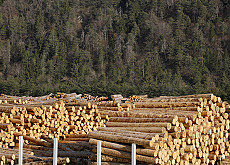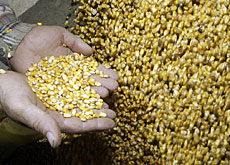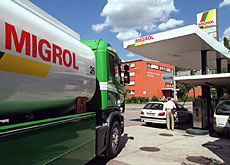Wood could be the fuel of the future

With the prospect of oil running out some time in the foreseeable future, Swiss researchers are looking for ways of keeping our cars running and our homes warm.
They have turned their attention to a familiar ally and one of Switzerland’s few plentiful renewable resources – wood.
When Hurricane Lothar wreaked havoc across western Europe on December 26, 1999, Switzerland was not spared. The damage caused by the storm’s ferocious winds on the country’s forests was so bad that it could be detected from space.
With so many trees felled, there was a glut of wood on the European market and prices dropped. Nearly eight years later, the situation has entirely changed.
The market has become so tight in countries including France that firewood is being imported from as far away as the Baltic states. Homeowners are turning to newer and more efficient wood-burning stoves to heat their homes, moving away from oil-based furnaces as the cost of petrol continues to rise.
Last year, a total of 5.7 million cubic metres of wood was collected in Switzerland, up eight per cent over 2006, according to the Federal Environment Office. The increase for heating wood – around a quarter of the harvest – was even higher at 13 per cent.
But while providing an interesting alternative to oil, it is not the most environmentally friendly solution, creating additional air pollution if there is no filter system.
Biomass gas
A far more efficient and cleaner process is being developed at the Paul Scherrer Institute (PSI), transforming wood into fuel that can be used either for heating or to generate electricity.
The process is not really new. For more than a century, chemists have known how to transform so-called biomass into gas. Perhaps one of the most enduring images of this technology is cars powered by wood gas during the Second World War.
But a looming oil crunch has made it attractive once again.
“Petrol will eventually run out, while biomass will still be around,” said Serge Biollaz, a researcher at PSI.
Biomass is usually defined as biological material, usually plants that can be used for fuel and industrial production, but sometimes it is also manure. It is usually considered to be carbon neutral, though this is not always the case, for example when deforestation occurs.
“Biomass is one solution, but it won’t solve all energy problems,” admits Biollaz. “It is interesting because you can convert it into a known commodity – natural gas, liquid fuel or electricity.”
In his laboratory at PSI, Biollaz is looking at how he can make the conversion process more efficient. Because while the facts are known, nothing comes easy: you cannot simply burn a few logs to extract some fuel.
“We have to convert the solid into a gas, then we have to clean the gas in such a way that it meets the requirements of the converter system,” he told swissinfo.
The task at hand is not just to extract the most gas possible from the biomass source, but also to scrub it up so that residues such as tar do not clog up the system or pollute the air.
Competitive?
Here in the laboratory, wood pellets are burnt in a chamber at high temperatures with little air, partial combustion producing the gas. This is then fed through a catalytic converter like those found on cars. If it is clean enough, it can then be used to drive a fuel cell.
So if it works, can this maze of pipes and meters be implemented on a larger scale? The jury is still out, although Biollaz believes it could compete with petrol and natural gas cost-wise.
In Switzerland, though, he says biomass is just one option among many when it comes to covering future energy needs. Whether it is worth the effort still has to be determined, but it is an attractive proposition depending on where it is used.
“Some people say we would be better off just taking the wood and producing heat from it. [But] biomass is a resource that is abundantly available. Twenty to 30 per cent of our prime electricity needs could be covered by it,” he added.
swissinfo, Scott Capper in Villigen
Biomass is part of the so-called carbon cycle.
Carbon from the atmosphere is converted into biological matter by photosynthesis. When it decays or is burnt, the carbon goes back into the atmosphere or soil.
This takes place over a fairly short period of time and plant matter used as a fuel can be constantly replaced by new growth.
Although fossil fuels have their origin in ancient biomass, they are excluded from the usual definition because they contain carbon that was taken “out” of the carbon cycle.
The Paul Scherrer Institute is a research centre for natural sciences and technology.
In collaboration with universities, other research institutes and industry, PSI is active in solid state physics, materials sciences, elementary particle physics, life sciences, nuclear and non-nuclear energy research, and energy-related ecology.
It is the largest national research institute with about 1,200 members of staff, and is the only one of its kind in Switzerland.

In compliance with the JTI standards
More: SWI swissinfo.ch certified by the Journalism Trust Initiative














You can find an overview of ongoing debates with our journalists here . Please join us!
If you want to start a conversation about a topic raised in this article or want to report factual errors, email us at english@swissinfo.ch.